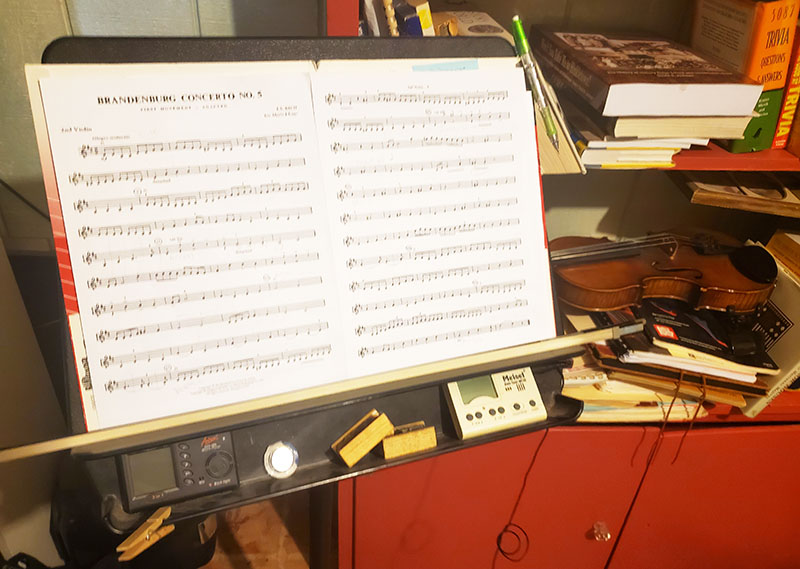
April 19, 2023–Music stands have always bothered me, but I couldn’t pinpoint the reason.
I remember buying my first one as a 5th-grade snare drummer. It was a clever contraption that folded up to fit in a backpack. Handy. But it was also flimsy when set up. Even a Percussion I book caused it to torque on its axis, inevitably spilling sheet music under the tuba section. The slightest breeze caused an origami shower, despite those silly folding pieces of wire designed to hold the pages down.
When we graduated to more substantial models, they had their own issues. They were heavy, not portable, and still wobbled and spilled music.
Regardless of quality, music stands are an essential piece of equipment for any serious performance, whether orchestra; or amateur jam session, or street-corner preacher.
From the performer’s point of view, a music stand is a musical crutch. Mostly it holds the music. But it also holds a pencil, rosin, extra picks, maybe a business card, cell phone, and car keys.
From the audience perspective, a music stand looms as a black hole, a bleak metal barrier between the player and listener. It blocks the view; it blocks the sound; it blocks the energy.
This came up during an interview with bassoonist Kara LaMoure, a founding member of the Houston-based WindSync, a wind quintet performing at the Cailloux Theater on April 23.
Their promo material describes the group as “breaking the fourth wall.” How do they do that, I asked?
“For classical music, one of the biggest and simplest ways you can break the fourth wall is to take away the music stands,” LaMoure said, to imaginary gasps from the conductor. “So we actually will be performing a part of our concert without music stands, just from memory. What that does is it lets the audience see exactly what we’re doing without that physical barrier. But it also lets us interact more closely. They can see how the gesture affects the music and the whole experience becomes more communal, because we can also share energy back and forth with the audience more easily, too.”
In that one reply, the Mystery of the Music Stand was disassembled. It makes us aware of the effect of what is essentially a piece of furniture can have on any artistic performance.
OK, I might have oversold the premise–this is not an earth-shattering exposé. But for me, it clarified how we erect barriers between us and our audiences. It doesn’t have to be a music stand. It might be a lectern at a speech, a centerpiece on a table, a cell phone in the living room. For all our lip service about connecting and conversing and starting a dialogue, we sure seem invested in velvet ropes, seating sections, and music stands.
But, there is hope. With all the forms of artificial entertainment within our grasps, it is encouraging that we still venture out to experience live performances.
“I think it is because a concert is an experience you can only have in real time,” LaMoure said. “It’s something that only exists in that moment. And every concert is a little bit different because the people who show up are different and we show up as different musicians. In live concerts, you get a really awesome feel for huge dynamics and exciting energy. And those are things that can’t be captured in any recording.”
So whether it’s a professional chamber group like WindSync, or the retired sheriff learning Cripple Creek on banjo at a jam session at the VFW, please… keep listening.
Details:
WindSync, a Houston-based quintet of recognized wind musicians who perform a repertoire of original arrangements, new works, and classical compositions, performs at the Cailloux Theater on Sunday, April 23, 2023, 3:00 pm
Tickets: caillouxperformingarts.com
(830) 896-9393